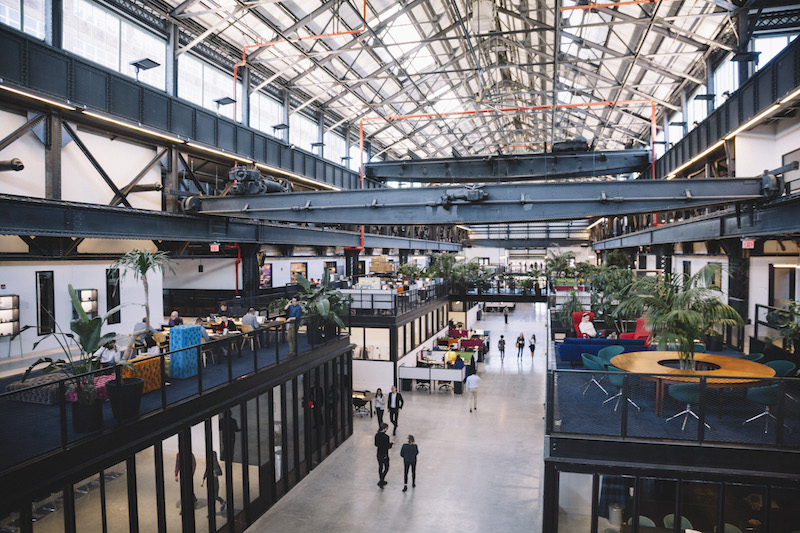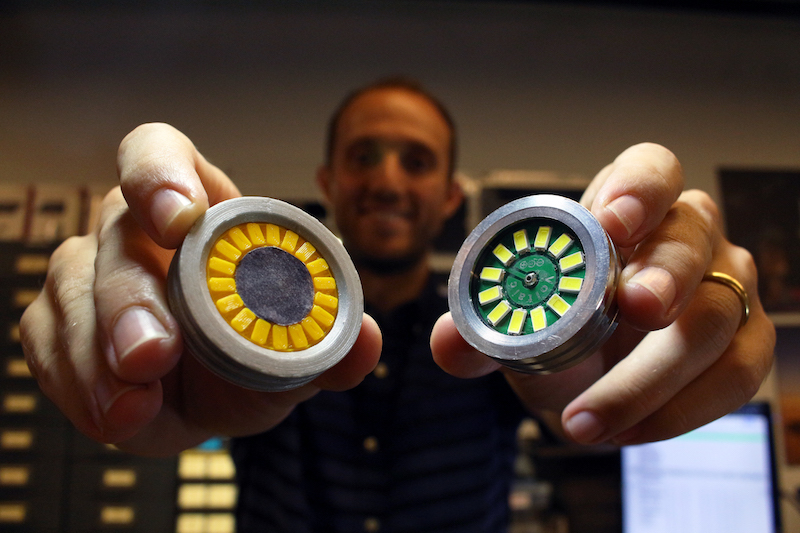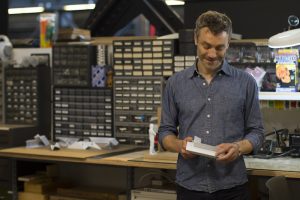In New York’s Brooklyn Navy Yard is a community of more than 100 companies, co-located in an area of over 84,000 square feet. This cluster is called New Lab, and it is home to designers, entrepreneurs, engineers and others working to develop new manufacturing technology through robotics, IoT, 3D printing, blockchain and more. The facility used to be a factory that built battleships, and it has been repurposed in an ingenious way, with several member-access fabrication shops giving member companies space to prototype, design and iterate. One of these member companies is 3D printer manufacturer Ultimaker.
“When Ultimaker joined New Lab as a member company, we brought with us a fleet of our latest-model professional desktop 3D printers and hundreds of spools of free filament that we made available for members to use with full 24-hour access at no charge for the first year and a half,” said Matt Griffin, Ultimaker’s Director of Community for North America.
After Ultimaker arrived with its 3D printers, New Lab was able to eliminate some higher-cost, higher-maintenance industrial FFF 3D printers, boosting their fabrication capability and capacity.
“For the members who might be interested in 3D printing, and in integrating 3D printing into their workflow, the largest barrier was that they either assumed that 3D printing could do anything, or that it couldn’t do the thing they needed it to,” said Alexander Susse, New Lab’s Director of Additive Manufacturing. “The way to get people to truly understand the usefulness of 3D printing is to just give them the tools and let them start trying to print things. You can’t really do that with some of the more industrial options.”
New Lab’s 3D Printing Lab currently has 12 Ultimaker 3D printers, available to be reserved for use at any time of the day or night. According to 10xBETA CEO Marcel Botha, it’s more useful to have numerous desktop 3D printers than one industrial printer – and it costs about the same.
“With our Ultimakers, we can finally use 3D printers for experimentation on the fly,” said Botha. “The original aim of iterating and rapid prototyping is, at the end of the day, to prototype – not to produce costly artifacts at each stage. When I print using SLS or high-end FFF solutions, I feel the parts that cost so much to produce are precious – but the only requirement for the printed parts is that they are something my team and I can look at for five minutes and then throw away. We’d rather buy three more Ultimakers than one $9k entry-level industrial-grade machine.”
Tony Kauffmann, Product Development Engineer at Voltaic Systems, has been able to use the 3D printers to eliminate several of the middle steps that slow down production.
“It definitely speeds things up,” he said. “Timelines overall have shrunk, but I’d say the real advantage for us is that it allows us to improve the quality of our products.”
Eric Forman of Eric Forman Studio uses Ultimaker’s 3D printers to complement the other tools he works with.
“I would say three-quarters of what I print is probably to assist with another tool,” he said. “…And now that I’ve expanded to using the actual 3D-printed parts in the final piece as the material itself, and not just as a helper, it’s a whole different ball of wax.”
Freelance mechanical engineer Arya Tabatabai has learned a lot from using the 3D printers at New Lab. He has discovered the usefulness of creating 3D printed prototypes that look just like the final parts, as he can give them to the industrial designers he works for to get immediate feedback. Of the many tools available at New Lab, he finds the 3D printers to be the most user-friendly.
“The Ultimakers are great tools for prototyping in general,” he said. “I’ve done a lot of research on desktop 3D printers, and from what I can see the Ultimakers are one of the best, if not the best in terms of the FFF category. It’s a strength to my work just using them, being able to think up something, CAD something up, and get it in front of you. Whether it’s in an hour or a day, that speaks for itself as to how beneficial it is.”
After getting so much use out of New Lab’s Ultimaker 3D printers, several member companies have considered getting their own 3D printers or to think about prototyping in new ways. Having 3D printers as a part of a collaborative community like New Lab has sparked a lot of creativity and allowed the member companies to make faster progress than they would have without these valuable tools.
Discuss this and other 3D printing topics at 3DPrintBoard.com or share your thoughts below.
[Source/Images: Ultimaker]
Subscribe to Our Email Newsletter
Stay up-to-date on all the latest news from the 3D printing industry and receive information and offers from third party vendors.
You May Also Like
3D Printing Webinar and Event Roundup: April 21, 2024
It’s another busy week of webinars and events, starting with Hannover Messe in Germany and continuing with Metalcasting Congress, Chinaplas, TechBlick’s Innovation Festival, and more. Stratasys continues its advanced training...
3D Printing Webinar and Event Roundup: April 14, 2024
We’re starting off the week’s 3D printing webinars and events at ASTM AMCOE’s 11th Snapshot Workshop and MACH Exhibition. Stratasys continues its advanced training courses, SME is holding a virtual...
Polly the Duck to Receive 3D Printed Bill Prosthetic
In Williamson County, Texas, a story of resilience, innovation, and cross-community effort is unfolding, illustrating the bond between humans and wildlife. All Things Wild, a wildlife rehabilitation center, has been...
3D Printing News Briefs, April 3, 2024: Kickstarter FDM 3D Printer, Artificial Eyes, & More
In 3D Printing News Briefs today, we’re talking about an FDM 3D printer on Kickstarter, advancements in artificial eye creation, and 3D printed solenoids for electromagnets. Then we’ll move on...




































